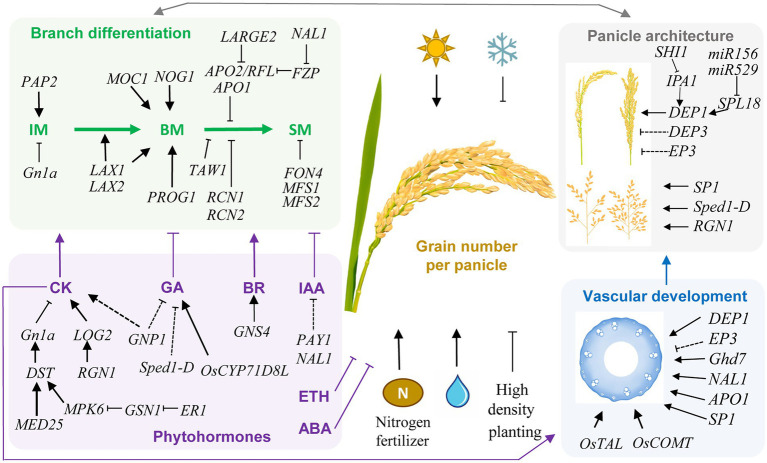Figure 1.
Schematic representation of genetic and environmental factors controlling grain number per panicle (GN) in rice. Key genes and regulatory pathways in controlling GN are indicated. Arrows indicate positive regulation, while T lines indicate negative regulation. Dashed lines indicate indirect regulations. Rice GN is determined by the panicle architecture and branch differentiation, which are associated with phytohormones and vascular development. These regulatory pathways are interconnected in regulating GN. In the determination of panicle architecture, the DEP1, DEP3, and EP3 genes control the dense and erect panicle type, while SP1, Sped1-D, and RGN1 regulate panicle length and branch number. Transcription factors IPA1 and SPL18 positively regulates the expression of DEP1. SHI1 interacts with IPA1 and inhibit its activity, while microRNAs miR156 and miR529 regulate the expression level of SPL18. The branch differentiation involves the activity and phase transition of inflorescence meristem (IM), branch meristem (BM), and spikelet meristem (SM). Increasing the meristem activity and delaying the transition from BM to SM have a positive effect on GN. Phytohormones were also crucial regulators of GN through manipulating branch differentiation, among which cytokinin (CK) and brassinosteroid (BR) are positive regulators, while indole 3-acetic acid (IAA), gibberellin (GA), abscisic acid (ABA), and ethylene (ETH) are negative regulators. The key GN regulator GN1a encodes a CKX, which negatively regulate CK level, and is regulated by the ER1-GSN1-MPK6-DST signal cascade, while MED25 functions as a coactivator with DST to promote expression of GN1a. Vascular development is closely associated with GN through affecting the panicle architecture and translocation capability for water and nutrients. Many GN-associated genes also function in regulating vascular development, while the key vascular development regulators OsTAL and OsCOMT both have significant positive effects on GN. Moreover, vascular development is positively regulated by CK. In addition, light, water, and nitrogen availability positively regulate GN, while low temperature and high planting density negatively control GN. These genetic and non-genetic factors together determine the GN of rice.

